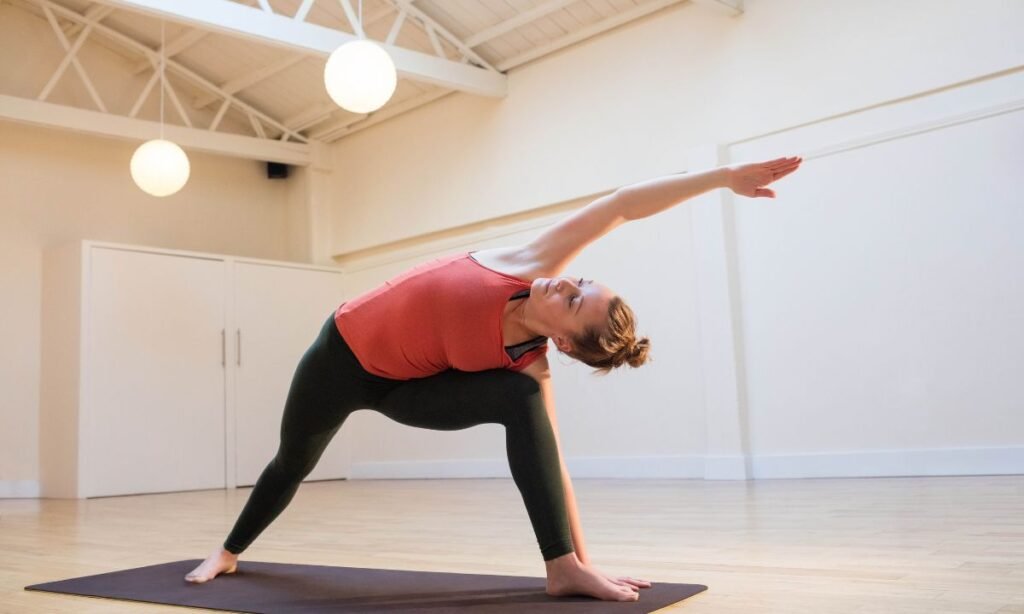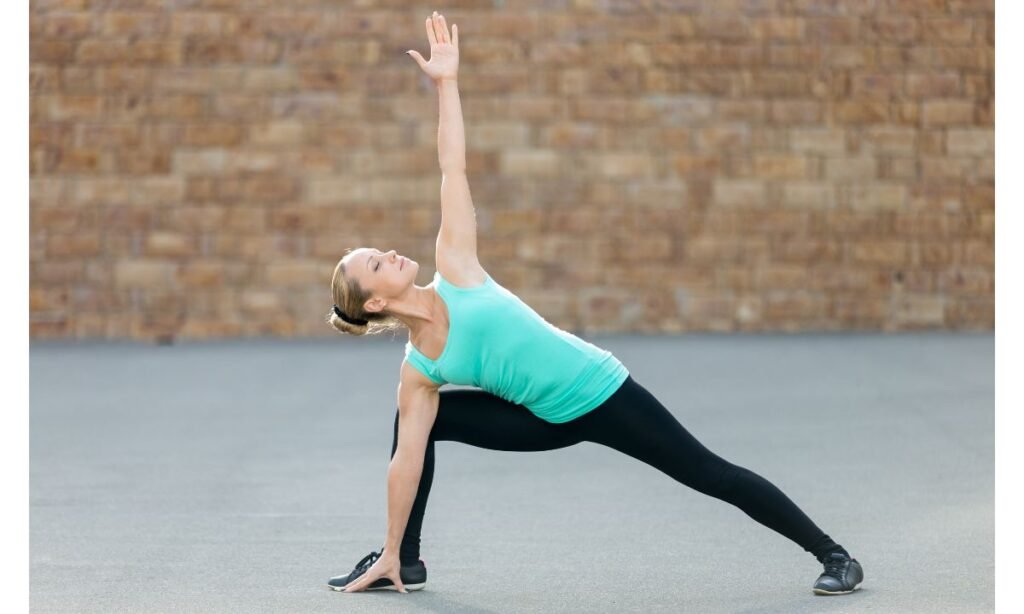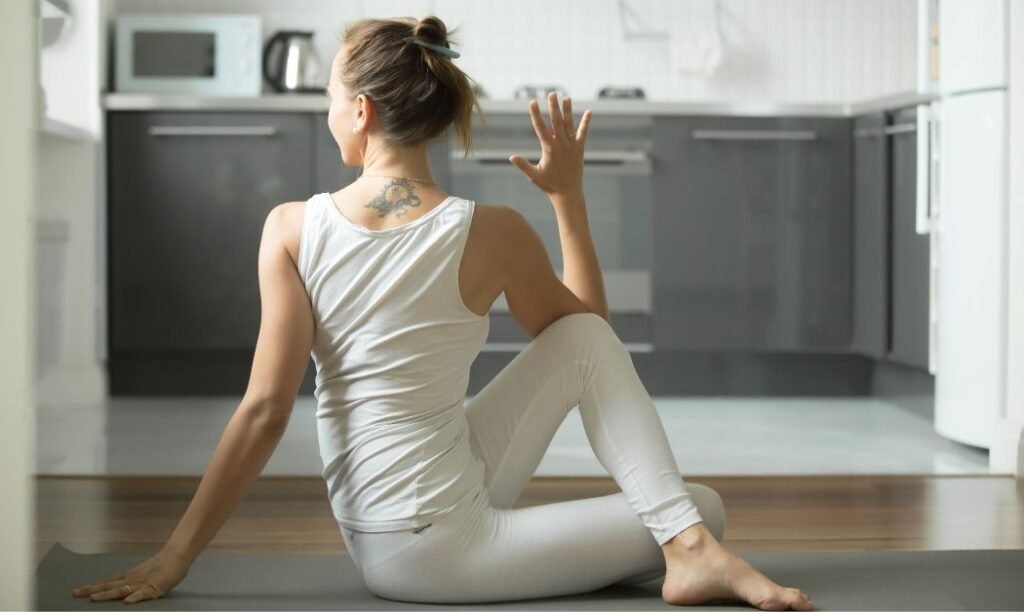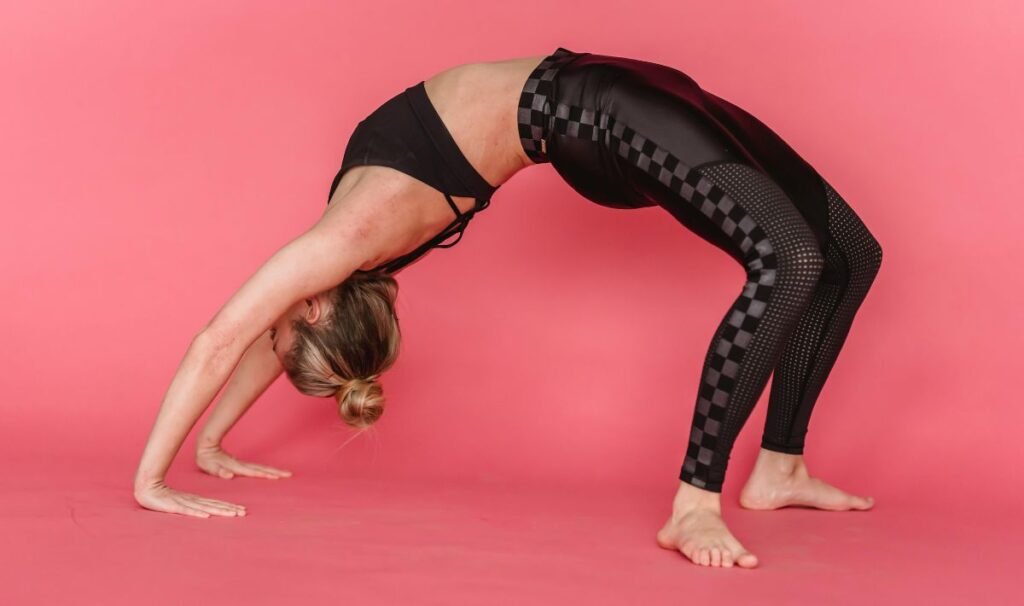Introduction
Yoga, an ancient practice for physical and mental well-being, has countless poses that promote flexibility, strength, and balance. One is the Extended Side Angle Pose, known in Sanskrit as Utthita Parsvakonasana. This pose not only stretches and strengthens the body but also brings awareness and energy flow, enhancing your yoga practice. In this blog post, you’ll learn how to practice the Extended Side Angle Pose, its benefits, and variations to suit different levels.
Whether you are a beginner or an experienced yogi, understanding how to perform Utthita Parsvakonasana correctly will help you make the most of its numerous advantages. Let’s dive in!
What Is the Extended Side Angle Pose (Utthita Parsvakonasana)?
The Extended Side Angle Pose (Utthita Parsvakonasana) is a standing yoga pose that combines strength, flexibility, and focus. “Utthita” means “extended,” “Parsva” means “side,” and “Kona” means “angle,” making this pose a literal embodiment of its name. This posture stretches the legs, hips, spine, and chest while engaging the core and building stability.
Benefits of the Extended Side Angle Pose
Utthita Parsvakonasana offers numerous physical and mental benefits. Here are some of the key benefits of practicing the Extended Side Angle Pose:
1. Enhances Flexibility
- Stretches the Side Body and Hips: This pose deeply stretches the side body, hips, and groin, increasing overall flexibility.
- Improves Spine Mobility: The lateral stretch helps release tension along the spine and promotes better spinal mobility.
2. Strengthens the Lower Body
- Leg Strength: The pose engages the quadriceps, hamstrings, and calves, strengthening the lower body.
- Engages the Glutes: By holding the position, you activate and build strength in the glutes, which supports better posture and movement.
3. Opens the Chest and Shoulders
- Enhances Breathing: Opening the chest allows deeper and more effective breathing, aiding in relaxation and increased oxygen flow.
- Relieves Shoulder Tension: Stretching the arms and shoulders can help relieve tightness and promote flexibility.
4. Builds Core Stability
- Activates the Core Muscles: The slight twist and engagement required for balance help activate and strengthen the core muscles.
- Improves Balance and Coordination: The pose requires balance, promoting better coordination and overall body awareness.
5. Improves Digestion
- Stimulates Digestive Organs: The side bends gently massage the abdominal area, supporting digestion and the function of the internal organs.
6. Increases Mental Focus and Concentration
- Promotes Mindfulness: Holding the pose with steady breathing enhances focus and encourages present-moment awareness.
- Relieves Stress: The combination of stretching and breathing helps reduce tension, promoting a sense of calm and stress relief.
Readmore: 15 Best Heart-Opening Yoga Poses
Readmore: Seated Forward Bend Pose (Paschimottanasana)
How to Do the Extended Side Angle Pose (Step-by-Step)

Performing Utthita Parsvakonasana correctly ensures that you reap its full benefits while preventing injury. Follow these step-by-step instructions:
Step 1: Set Up Your Foundation
- Start in Tadasana (Mountain Pose) at the top of your mat.
- Step your left foot back about 3 to 4 feet, keeping your right foot forward. Align your heels.
Step 2: Position Your Feet
- Right Foot: Point it forward.
- Left Foot: Angle it slightly inward, at approximately 45 degrees.
Step 3: Bend the Front Knee
- Bend your right knee until it aligns directly over your ankle, creating a 90-degree angle. Make sure your thigh is parallel to the ground.
- Keep your left leg straight and active.
Step 4: Extend the Torso
- Lean your torso over your right thigh. Ensure your core is engaged and your chest is open.
Step 5: Place Your Right Hand
- Rest your right hand on the floor outside your right foot, on a block, or on your shin, depending on your flexibility.
Step 6: Extend the Top Arm
- Reach your left arm over your head, creating a straight line from your left foot to your fingertips. Your palm should face down, and your shoulder should stay away from your ear.
Step 7: Maintain Alignment
- Ensure your hips remain open and your chest stays lifted toward the ceiling.
- Keep your gaze forward, up, or down, depending on your balance and comfort.
Step 8: Hold the Pose
- Breathe deeply and hold the pose for 30 seconds to 1 minute.
Step 9: Release and Repeat
- To come out of the pose, press through your feet, engage your core, and lift your torso back up. Repeat on the opposite side.
Mistakes to Avoid
When practicing Utthita Parsvakonasana, it’s crucial to maintain proper form to avoid injury. Here are some common mistakes and tips to avoid them:
1. Overextending the Knee
- Mistake: The knee moves beyond the ankle.
- Solution: Keep the knee stacked directly above the ankle to prevent strain.
2. Collapsing the Chest
- Mistake: Letting the chest collapse forward.
- Solution: Rotate your chest upward to maintain an open and expansive posture.
3. Incorrect Foot Position
- Mistake: The back foot is not properly angled, affecting balance and hip alignment.
- Solution: Position the back foot at a 45-degree angle and keep the entire sole grounded.
4. Hunching the Shoulders
- Mistake: Shoulders creep up toward the ears.
- Solution: Keep your shoulder blades relaxed and draw them down your back.
Readmore: The Best Foods for a Yogic Diet
Readmore: Yoga for Better Sleep Simple Poses
Variations of Extended Side Angle Pose
To cater to different levels of flexibility and strength, there are variations of the Extended Side Angle Pose that you can try:
1. Modified Extended Side Angle Pose (Beginner-Friendly)
- Use a Block: Place a yoga block under your hand for added support and stability.
- Rest on the Thigh: Instead of reaching for the floor, rest your forearm on your front thigh.
2. Bound Extended Side Angle Pose (Baddha Utthita Parsvakonasana)
- Instructions: Wrap your bottom arm under your thigh and reach your top arm behind your back to clasp your hands.
- Benefits: This variation provides a deeper shoulder and chest stretch.
3. Revolved Side Angle Pose (Parivrtta Parsvakonasana)
- Instructions: Instead of extending to the side, twist your torso toward the bent knee, placing the opposite elbow on the outside of the knee and reaching the other arm up.
- Benefits: Engages the obliques and enhances spinal flexibility.
4. Extended Side Angle Pose with Extended Arm
- Instructions: Extend the top arm straight up instead of over the head for an alternative shoulder stretch.
- Benefits: Reduces the intensity while still engaging the core and shoulders.
5. Extended Side Angle Pose with a Chair
- Instructions: Place a chair next to your front foot and rest your hand on the seat for additional support.
- Benefits: Ideal for those who need extra balance support or are working through limited flexibility.
Utthita Parsvakonasana in Your Yoga Routine
Incorporating Utthita Parsvakonasana into your regular yoga practice can enhance your flexibility, strength, and balance. Here are some ways to include this pose:
- Warm-Up Sequence: Use this pose after basic warm-up stretches and lunges to activate your legs and hips.
- Strength-Building Flow: Pair it with Warrior II (Virabhadrasana II) and Triangle Pose (Trikonasana) for a powerful standing series.
- Cool Down: Use a modified version as part of your cool-down to promote gentle stretching and relaxation.
Safety Tips and Precautions
Before practicing the Extended Side Angle Pose, keep these safety tips in mind:
- Consult with a Professional: If you have any injuries, particularly in the knees, hips, or shoulders, consult a qualified yoga instructor or physical therapist.
- Listen to Your Body: Avoid pushing yourself beyond your comfort zone. A slight stretch is beneficial, but pain is not.
- Use Props: Don’t hesitate to use yoga blocks, straps, or other props to ensure a safe and comfortable practice.
Final Thoughts
The Extended Side Angle Pose (Utthita Parsvakonasana) is a versatile and powerful posture that offers a wide range of benefits for practitioners of all levels. From increasing flexibility and strength to improving digestion and mental focus, this pose is a must-have in any well-rounded yoga routine. By mastering its steps and understanding how to modify it, you can enjoy a fulfilling and safe yoga practice tailored to your needs.
Try incorporating this pose into your next practice, experiment with variations, and notice how your body responds. Consistency and mindful practice will lead to noticeable improvements in both your physical and mental well-being.
Readmore: Scorpion Pose (Vrischikasana)
Readmore: King Cobra Pose (Raja Bhujangasana)
FAQs about Extended Side Angle Pose (Utthita Parsvakonasana)
1. What is the Extended Side Angle Pose?
The Extended Side Angle Pose (Utthita Parsvakonasana) is a standing yoga pose that stretches and strengthens the legs, hips, and side body while engaging the core. It also helps open the chest and improve balance and flexibility.
2. What are the benefits of practicing Utthita Parsvakonasana?
Practicing this pose offers numerous benefits, including enhanced flexibility, improved lower body strength, chest and shoulder opening, better core stability, improved digestion, and increased mental focus and concentration.
3. How do I perform the Extended Side Angle Pose correctly?
Start in a standing position and step one foot back. Bend the front knee at a 90-degree angle and extend the opposite arm over your head while placing your hand on the floor, a block, or your shin. Ensure your chest is open and your hips remain aligned.
4. What are some common mistakes to avoid in this pose?
Common mistakes include overextending the knee beyond the ankle, collapsing the chest forward, incorrect foot positioning, and hunching the shoulders. Keeping proper alignment and listening to your body are essential for safe practice.
5. Can beginners practice the Extended Side Angle Pose?
Yes, beginners can practice this pose with modifications. Using a yoga block under the bottom hand or resting the forearm on the front thigh can help maintain stability and comfort.

Sonu is a passionate yoga teacher with over 6+ years of experience helping individuals find balance, strength, and inner peace through the transformative power of yoga. As the creator of Pure Yoga Vibes, Sonu shares expert insights, inspiring practices, and a wealth of knowledge to support your wellness journey. Dedicated to creating a space for growth and mindfulness, Sonu’s mission is to make yoga accessible and enjoyable for everyone. For inquiries or collaborations, feel free to reach out at contact@pureyogavibes.com.



